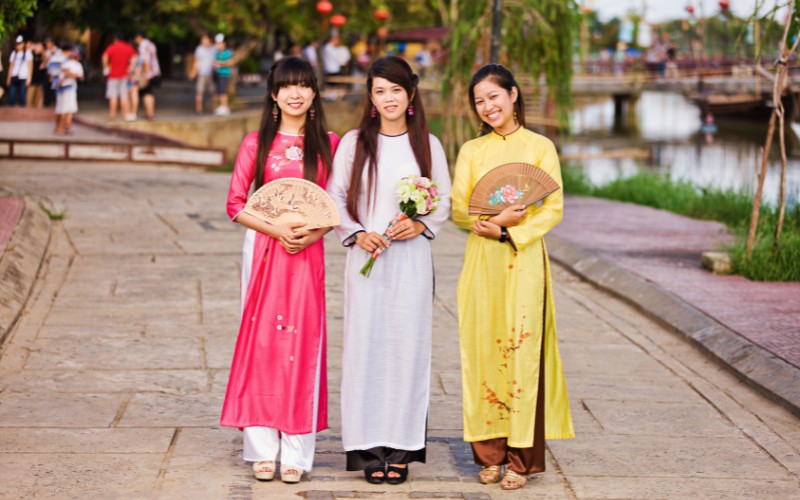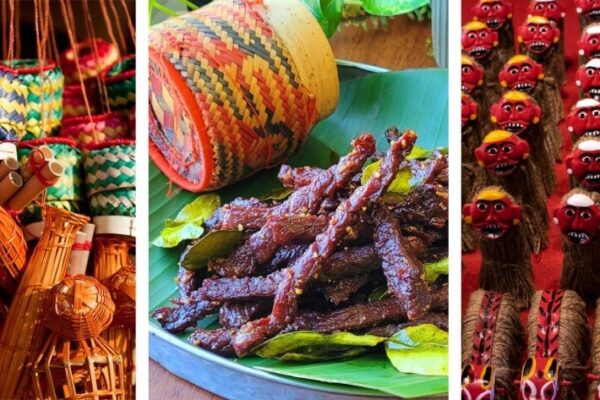21 Unique Vietnam Souvenirs That Travelers Should Buy

Collecting unique souvenirs while traveling is an excellent way to cherish memories and bring a piece of the destination back home. Vietnam, with a rich culture and vibrant markets, offers a wide range of fascinating souvenirs that travelers should consider. From traditional crafts to delicious treats, this article will provide necessary information about 21 unique Vietnam souvenirs that are sure to captivate your senses and teach you the secrets of successful souvenir shopping with expert tips.
12 Local Vietnam Souvenirs To Bring Back Home
Ao Dai
One of the most iconic symbols of Vietnam is the elegant Ao Dai. This traditional Vietnamese dress is fashionable and represents the country’s rich cultural heritage.
Vietnam’s national dress with its unique beauty
The Ao Dai is a long, flowing tunic worn by both men and women in Vietnam, although it is primarily associated with women’s fashion. It consists of a tight-fitting, high-collared top that extends down to the hips and is paired with long, flowing pants that reach the ankles. The tunic is often made from luxurious silk or other lightweight fabrics, and it is tailored to fit the wearer’s body shape, creating a graceful and flattering silhouette.
Where To Buy It
Tailor Shops: In major cities like Hanoi and Ho Chi Minh City, there are numerous tailors that specialize in creating bespoke Ao Dai. They can guide you in choosing the fabric, design, and measurements to ensure a perfect fit. The price can range from approximately $50 to $300 or more.
Local Markets: Ben Thanh Market in Ho Chi Minh City or Dong Xuan Market in Hanoi, often have stalls selling ready-to-wear Ao Dai. These markets offer a wide variety of designs and sizes at different prices from $20 to $100. However, keep in mind that the fit might not be as tailored as a custom-made Ao Dai.
What You Should Know
Pay attention to the fabric quality when choosing an Ao Dai. Silk is popular due to its luxurious feel and appearance, but other options like chiffon or synthetic blends are available.
Ao Dai has various designs, from simple and understated to intricately embroidered or embellished styles. Choose a design that resonates with your taste and preferences.
If you opt for a custom-made Ao Dai, make sure to provide accurate measurements to the tailor. They will guide you through the process and ensure the garment fits you perfectly. For ready-to-wear Ao Dai, try them on and check the fit, paying attention to the shoulders, waist, and length.
Conical Hats
The conical hat, also known as the “nón lá” in Vietnamese, is one of the famous things in Vietnam that tourists are attracted to.

Conical hats in daily life
The conical hat is a type of hat with a wide brim and a conical shape. It is typically made from natural materials such as palm leaves, bamboo, or straw. The hat is lightweight, breathable, and provides shade from the sun, making it ideal for Vietnam’s hot and humid climate. Besides being a practical accessory, it is also worn as a fashion statement and is deeply rooted in Vietnamese traditions and folklore.
Where To Buy It
Local Markets: Visit bustling local markets like Ben Thanh Market in Ho Chi Minh City or Dong Xuan Market in Hanoi. Basic conical hats range from around $1 to $2.
Souvenir Shops: Many souvenir shops in major tourist areas, such as Hoi An Ancient Town or the Old Quarter in Hanoi, offer conical hats as souvenirs. In these places, you can expect to pay from $2 to $5 for a conical hat.
Craft Villages: Explore traditional craft villages like Chuong Village in Hanoi or Kim Bong Village in Hoi An. These villages specialize in making handicrafts, including conical hats. The handmade conical hats crafted by skilled artisans can cost from $5 to $20 or even more.
What You Should Know
- Conical hats come in different sizes, so choose one that fits comfortably on your head. It should neither be too tight nor too loose.
It also comes in various designs, with different patterns or decorations. Select a design that appeals to you and reflects your personal style.
Tribal Textiles
Tribal textiles in Vietnam are handmade textiles created by ethnic minority groups living in the country’s mountainous regions. Each ethnic group has its distinctive weaving techniques, patterns, and motifs, making these textiles unique and culturally significant. The textiles are often made using traditional methods passed down through generations, using materials like cotton, hemp, silk, or a combination of these fibers.
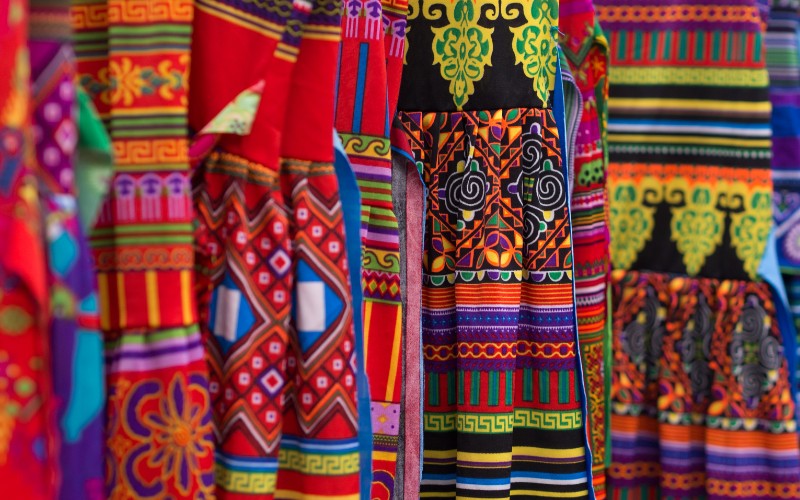
Traditional clothing of Vietnam Hmong minorities
Where To Find It
- Visiting the northern mountainous regions, such as Sapa, Ha Giang, and Mai Chau is recommended. Some famous textile markets in these regions include Bac Ha Market, Can Cau Market, and Dong Van Market.
- Smaller items like scarves or smaller woven pieces can range from approximately $4 to $20. Medium-sized textiles, such as table runners or wall hangings, can range between $20 to $65. Larger and more intricate textiles, such as traditional costumes or bedspreads, can cost more than $65 depending on the piece’s size, complexity, and rarity.
What You Should Know
- Look for textiles that are genuinely handmade by local artisans. Avoid mass-produced or machine-made imitations.
Whenever possible, buy directly from the artisans or cooperatives. This ensures your purchase benefits the local communities and helps sustain their traditional craft practices.
If you plan to use or display the textiles, ensure they are properly cared for to preserve their beauty and longevity. Follow any care instructions provided by the seller or seek professional advice if needed.
>> Explore Ha Giang and its tribal textiles in this tour: Ha Giang Meet The Local
Silk Products
Vietnam produces a variety of silk products, such as clothing, scarves, accessories, traditional handicrafts, and home decor items. The silk made in Vietnam, which is generally derived from the cocoons of silkworms, is famous for its top-notch quality, smooth texture, and shiny look. The traditional silk weaving techniques have been passed down through generations, and today, Vietnam is recognized as the world’s sixth-largest silk producer and the third-largest silk exporter in Asia.
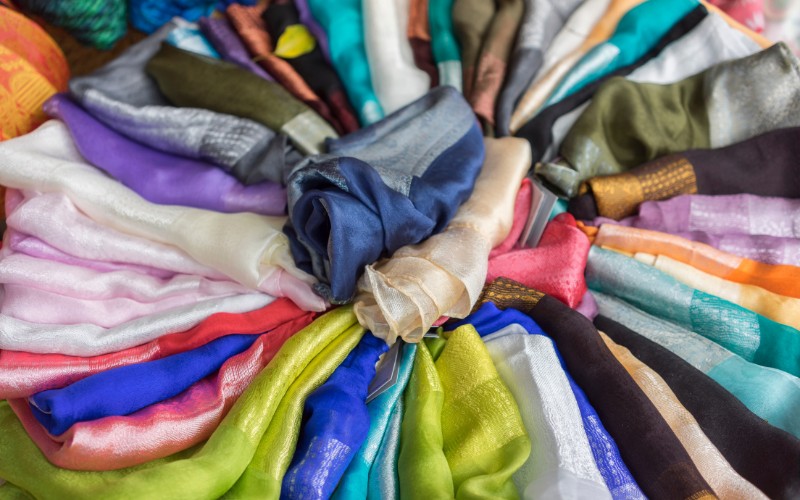
High-quality silk in Vietnam
Where To Buy It
Dong Xuan Market and Hang Gai Street (Silk Street) in Hanoi.
You can find customized silk garments and accessories in local tailor shops and boutiques in Hoi An.
Ben Thanh Market and Saigon Square are popular spots to explore silk products in Ho Chi Minh City.
Sapa is known for its ethnic minority communities and traditional crafts. Here, you can find unique silk products that reflect the local culture.
Its Price Range
Silk Scarves: from approximately $6.5 to $22 for standard-sized silk scarves.
Silk Clothing: Ready-to-wear silk dresses, blouses, or shirts can range from $22 to $87. Custom-made silk clothing may have higher prices, depending on the complexity of the design and tailoring.
Silk Accessories: Silk ties, bowties, pocket squares, and handkerchiefs can range from $9 to $35 depending on the quality and brand.
Home Decor Items: Silk cushion covers, table runners, wall hangings, and other decorative pieces can vary widely in price. It can range from $13 to $130 or more.
What You Should Know
Look for reputable sellers who offer genuine silk products. Pay attention to the quality of the fabric, the finishing details, and the reputation of the seller or shop.
- Examine the silk product carefully for any defects, loose threads, or color discrepancies. Check the seams, stitching, and overall craftsmanship to ensure you’re getting a high-quality item.
Ask the seller for specific care instructions for the silk product you’re purchasing. Silk requires delicate handling and maintenance, so it’s essential to know how to preserve its quality.
Hand Embroidery
Embroidery has a long history in Vietnam, dating back to ancient times. Various cultural and artistic traditions, including Chinese, French, and indigenous Vietnamese styles have influenced it.
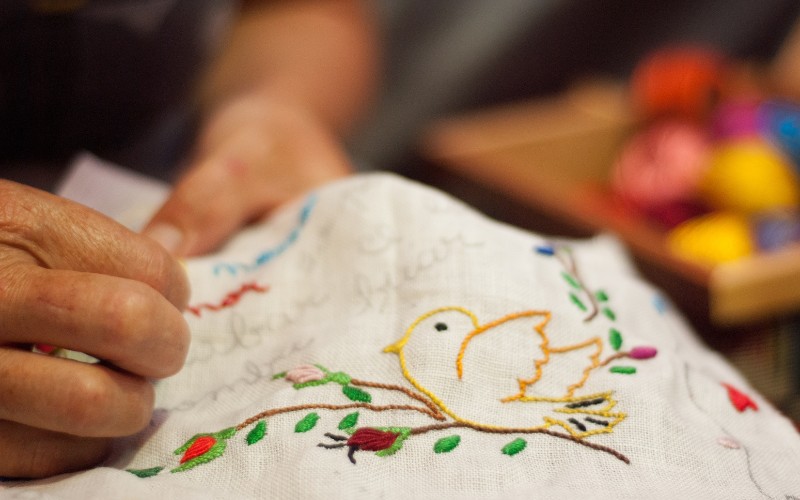
Skilled hands bring intricate designs to life through hand embroidery
Hand embroidery involves stitching intricate designs onto fabric using a needle and thread. It is a meticulous and time-consuming process that requires great skill and attention to detail. The embroidery is often done on silk, satin, or cotton fabric, and the designs can range from traditional motifs to contemporary patterns.
Where To Buy It
The Old Quarter and Dong Xuan Market in Hanoi are popular places to find hand embroidery and other traditional crafts.
Ben Thanh Market and Saigon Square in Ho Chi Minh City are known for their handicrafts, including hand embroidery.
Hoi An, an ancient town in central Vietnam, is renowned for its traditional crafts. You can visit the Hoi An Handicraft Workshop or explore the local markets to find beautiful hand-embroidered items.
Sapa is home to ethnic minority communities known for their textile traditions. You can find unique hand-embroidered products in the local markets and villages.
What You Should Know
Look for genuine hand-embroidered pieces made by skilled artisans. Mass-produced or machine-made items may lack the quality and craftsmanship of handmade pieces.
- Some artisans offer customization services, allowing you to request personalized designs or specific colors. This can be a great way to get a unique and meaningful souvenir.
Dong Ho Paintings
As a unique and vibrant traditional art form from northern Vietnam, Dong Ho paintings feature distinctive folk themes and printing techniques.

Yin-yang pig – A famous Dong Ho painting (Source: Collected)
The art products are typically made using woodblocks and natural colors extracted from materials like bark, leaves, and minerals. The process involves carving intricate designs onto wooden blocks, applying ink or colors to the blocks, and then printing the images onto traditional Vietnamese paper known as “do” paper. The paper is made from the bark of the “do” tree and is known for its durability.
These paintings are known for their cheerful and optimistic themes, reflecting the cultural heritage and values of the Vietnamese people.
Where To Buy It
The village of Dong Ho: It is located about 35 kilometers east of Hanoi. You can also witness the traditional printing process and purchase paintings directly from the artisans.
You can also find it in art galleries, craft stores, and souvenir shops in major cities and tourist destinations.
- The prices of Dong Ho paintings can vary depending on factors such as size, design complexity, and the artist’s reputation. Smaller paintings or prints can range from a few dollars to around $50, while larger and more intricate pieces can cost several hundred dollars or more.
What You Should Know
Look for paintings that bear the seal or stamp of the Dong Ho village, ensuring their authenticity.
Check the quality of the “do” paper, colors, and ink used in the painting. The paper should be sturdy and long-lasting, while the colors should be vibrant and resistant to fading.
Paper Lanterns
The glowing paper lanterns have a rich and meaningful history in Vietnamese culture, especially during the Mid-Autumn Festival. It brings families and communities together to celebrate and partake in various activities, all while symbolically warding off evil spirits and inviting good luck into their lives with the lighting of these lanterns.
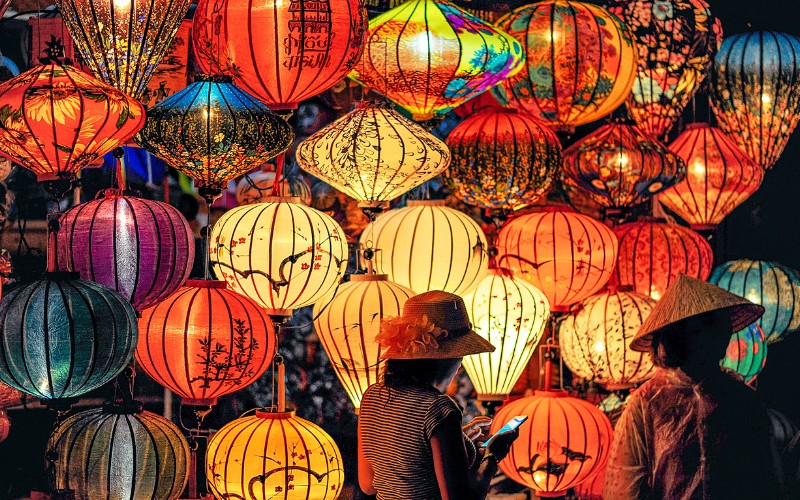
A mesmerizing glow stems from vibrant Vietnamese paper lanterns
Where To Buy It
You can find various types of lanterns in the Ben Thanh Market in Ho Chi Minh City, the Old Quarter in Hanoi, or the Old Town Hoi An which is particularly renowned for its lanterns.
The prices can vary depending on their size, design, and the location where you purchase them. Usually, smaller lanterns suitable for handheld use can range from a few dollars to around $10. Larger and more intricately designed lanterns can cost anywhere from $20 to $50 or more, depending on their complexity and craftsmanship.
What You Should Know
- Look for lanterns made with sturdy bamboo frames and durable, high-quality paper. This ensures they will last longer and retain their beauty.
Paper lanterns come in various designs, patterns, sizes, and colors. Consider vibrant hues like red, yellow, and green, which are often associated with luck and prosperity.
Pottery and Ceramics
Vietnamese pottery and ceramics can be found in various forms, including vases, bowls, plates, figurines, and decorative items. They are highly regarded for their exquisite designs, intricate patterns, and diverse range of styles.

Pottery products of Bat Trang Ceramic Village
Chinese and Cham cultures greatly influenced Vietnamese ceramics, but they developed their own unique characteristics over time. Traditional techniques were passed down through generations, and today, both traditional and contemporary styles of pottery and ceramics are produced in Vietnam.
Where To Buy It
You can visit the craft villages to choose the best ceramic products: Bat Trang Ceramic Village and Phu Lang Pottery Village in Hanoi, or Chu Dau Ceramic Village in Hai Duong.
Hoi An is also famous for its vibrant arts and crafts scene. You can explore numerous art galleries, boutiques, and workshops that offer a diverse range of pottery and ceramic products.
Its Price Range
Small Decorative Items: Like figurines, small bowls, or decorative pieces can range from a few dollars to around $20 or $30, depending on the intricacy of the design and the quality of workmanship.
Medium-Sized Vases and Bowls: These products with more elaborate designs and higher-quality craftsmanship can cost anywhere from $30 to $100 or more.
Large or Specialty Pieces: Large vases, intricate sculptures, or specialty pieces, can range from several hundred dollars to several thousand dollars, depending on their size, complexity, and the reputation of the artist or workshop.
What You Should Know
Look for pottery and ceramics that are handmade by local artisans. These pieces often have unique characteristics and exhibit the cultural heritage of Vietnam.
- Seek recommendations from locals or reputable guides who can direct you to reliable shops, artisans, or villages known for their pottery and ceramics.
Pay attention to the craftsmanship, glazing, and finishing quality. Examine the piece closely for any cracks, chips, or imperfections.
If you plan to buy larger or fragile items, inquire about appropriate packaging and shipping services to ensure your purchase arrives safely at your destination.
Propaganda Posters
Vietnamese propaganda posters typically feature bold, vibrant designs with powerful imagery and slogans. They were used as a means of communication and propaganda by the government to convey political messages, promote unity, and inspire patriotism among the Vietnamese people. These posters often depicted heroic figures, soldiers, workers, and peasants, along with symbols of the Communist Party and slogans advocating for revolution and national liberation.
Where To Buy It
Street markets, such as the Old Quarter in Hanoi or Ben Thanh Market in Ho Chi Minh City, often have vendors selling various types of souvenirs, including propaganda posters. These markets offer a wide range of options and bargaining opportunities.
Antique shops and galleries in major cities like Hanoi and Ho Chi Minh City may have vintage propaganda posters available for sale.
Some museums and art galleries in Vietnam, particularly those focused on history and art, may have exhibitions or dedicated sections where you can view and purchase replicas or prints of propaganda posters.
- Prices can range from a few dollars for low-quality reproductions to several hundred dollars or more for well-preserved originals or rare pieces.
What You Should Know
- The prices of Vietnamese propaganda posters can vary depending on factors such as authenticity, rarity, condition, and the seller’s location. Vintage and original posters are generally more expensive compared to reproductions or prints.
If you’re seeking authentic posters, buying from reputable sources, such as established galleries or trusted antique dealers is essential.
Examine the poster for any damage, such as tears, stains, or discoloration, and assess its overall preservation before making a purchase.
If you plan to transport the poster or display it, inquire about suitable packaging or framing options. Rolled posters are easier to transport, while framed ones are ready for display but may require extra care during transit.
Bamboo Root Carvings
Renowned for their intricate details and natural beauty, the bamboo root carvings are the distinctive Vietnam souvenir. The craftsmen utilize the natural shape and texture of bamboo roots to create stunning sculptures that often depict various subjects such as animals, landscapes, and mythological figures. The carvings showcase the mastery of the artists in bringing out the hidden beauty of the bamboo material.

Unique faces of bamboo root carvings
Where To Buy It
Dong Xuan Market and Night Market in Hanoi, or Ben Thanh Market and Binh Tay Market in Ho Chi Minh City.
You can also find bamboo root carvings in local shops and art galleries scattered throughout the big city.
- Small and simple carvings could range from $10 to $50. Larger and more intricate pieces, or those crafted by renowned artists, can fetch prices ranging from $100 to several hundred dollars.
What You Should Know
Ensure that the carving is made from genuine bamboo roots. Some mass-produced imitations may use other materials, such as wood, to mimic the appearance of bamboo roots.
Bamboo root carvings are susceptible to damage from pests and humidity. If you plan to bring the carving home, inquire about preservation methods or instructions to ensure its longevity.
Vietnam Calligraphy
Calligraphy, or “thư pháp” in Vietnamese, is the art of writing beautifully using brush and ink. Vietnam calligraphy is characterized by its elegant strokes, intricate designs, and the use of Chinese characters and Vietnamese ideograms. It is deeply rooted in Confucianism, Taoism, and Buddhism, and often features famous quotes, proverbs, or verses from classical literature and philosophical teachings.
The calligraphic art form is highly regarded and practiced by talented artisans and scholars who have mastered the techniques and principles of this ancient craft.
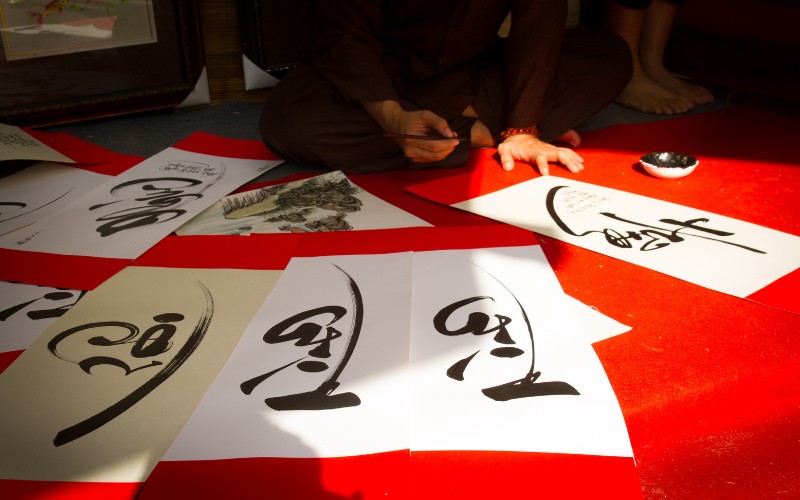
Vietnamese calligraphy has evolved into the art of beautifying each character
Where To Buy It
Temples and Pagodas: Many temples and pagodas in Vietnam have calligraphers who create custom pieces or display their artwork. Visitors can witness the artists in action and even request personalized calligraphy.
Traditional Art Villages: Places like Hanoi’s Van Phuc Silk Village or Hue’s Phuoc Tich Village are known for their calligraphic works.
Artisan Markets: Local markets, such as Dong Xuan Market in Hanoi or Ben Thanh Market in Ho Chi Minh City, often have stalls or sections dedicated to traditional arts and crafts, including calligraphy.
- Small or standard-sized calligraphy pieces may range from a few dollars to around $50. Larger or more intricate works can be significantly more expensive, potentially reaching a few hundred dollars or more.
What You Should Know
- Calligraphy is traditionally done using ink and brush on rice paper. Ensure that the materials used are of good quality, as this affects the longevity and appearance of the artwork.
If you wish to have a personalized calligraphy piece, communicate your requirements clearly to the calligrapher. Specify the characters, quotes, or verses you want, and ensure they understand your preferences.
Vietnam Musical Instruments
Vietnam is renowned for its rich musical heritage, and Vietnamese musical instruments are popular souvenirs for visitors to the country. These instruments reflect the cultural traditions of Vietnam and showcase local artisans’ craftsmanship and artistry.
Some Notable Musical Instruments
Dan Tranh (16-string zither): The Dan Tranh is a traditional plucked zither with 16 strings. It has a trapezoidal wooden body and is played using finger picks. It produces a soothing and melodic sound often associated with traditional Vietnamese music. Prices for a good quality Dan Tranh can range from $100 to $500.
Dan Bau (monochord zither): The Dan Bau is a unique Vietnamese instrument consisting of a single string stretched over a resonating gourd. It is played by plucking the string while simultaneously manipulating a bamboo rod to change the pitch. Dan Bau has a distinctive, haunting sound and is often used in Vietnamese folk music. Prices for a đàn bầu can range from $50 to $150.
Dan Nguyet (two-string moon lute): This instrument is a two-stringed lute shaped like a crescent moon. It has a long neck and a round soundbox. The instrument is played by plucking the strings with a wooden pick. Dan Nguyet produces a mellow and melancholic sound and is commonly used in Vietnamese classical music. It might cost from $50 to $200 to have a Dan Nguyet.
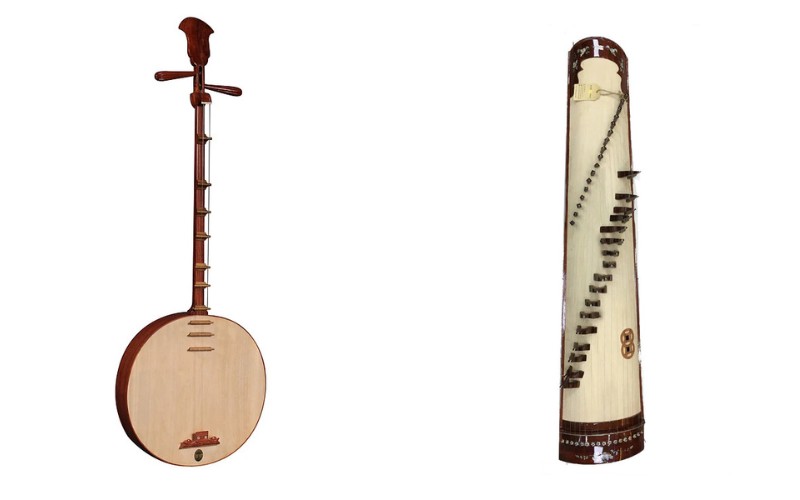
Dan Nguyet and Dan Tranh
Where To Buy It
Popular markets, like the Old Quarter Night Market in Hanoi and Ben Thanh Market in Ho Chi Minh City.
Additionally, specialized music stores and craft villages, such as Bat Trang Ceramic Village near Hanoi, may offer a wider selection of instruments.
What You Should Know
- Test the instrument’s sound before purchasing, if possible. Ensure that it produces a clear and pleasing tone.
Inspect the instrument for any structural flaws or damage. Pay attention to the quality of wood, strings, and other components.
Consider the size and weight of the instrument, especially if you plan to take it back as a souvenir. Some instruments, like Dan Tranh or Dan Bau, can be quite large and may require special arrangements for transportation.
9 Editable Famous Things In Vietnam To Buy
Vietnamese Coffee
Coffee is a distinctive specialty in Vietnam with robust flavor and unique brewing methods. Traditional Vietnamese coffee is made using a small metal drip filter called a “phin.” It typically consists of dark roasted coffee beans, often blended with a small amount of chicory, which gives it a distinct taste. The coffee is usually prepared with condensed milk, creating a sweet and creamy beverage. However, you can also find black coffee or variations with different levels of sweetness.
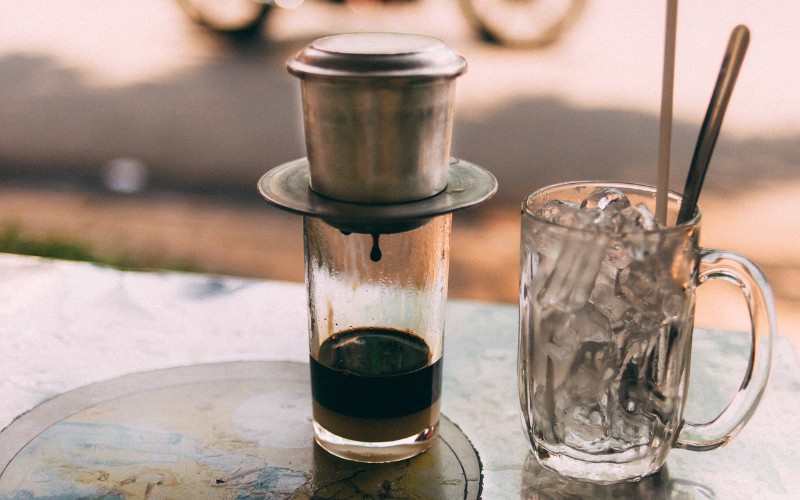
Filter coffee brewing is the most popular way
Where To Buy It
Vietnamese coffee is widely available throughout Vietnam. You can find it in local coffee shops, street stalls, and even in upscale cafes.
In major cities like Hanoi, Ho Chi Minh City, and Da Nang, you’ll come across numerous coffee shops offering a variety of Vietnamese coffee options.
Additionally, you can purchase packaged coffee beans or ground coffee to take home as a souvenir. These are available at local markets, supermarkets, and specialized coffee shops.
- On average, a pack of ground coffee or whole beans can range from $5 to $15, depending on the quantity and quality. In local coffee shops, a cup of brewed coffee typically costs between $1 and $3, while specialty coffee drinks or iced coffee variations might be slightly higher in price.
What You Should Know
Look for reputable brands or coffee produced by local coffee farms. Check the packaging for any certifications or indications of quality.
Vietnamese coffee is often available in different roast levels, from medium to dark roast. Each roast level offers a distinctive flavor profile, so choose according to your preference.
Decide whether you prefer pre-ground coffee or whole beans. Whole beans offer greater freshness and control over the grind size if you have a coffee grinder.
Ensure the packaging is airtight and properly sealed to preserve the coffee’s freshness and aroma.
>> Read More: Best 5 Vietnam Destinations For Coffee Lovers
Coconut Candy
Vietnam coconut candy, also known as Keo Dua in Vietnamese, is typically produced in the Mekong Delta region of Vietnam, where coconuts are abundant. The process of making coconut candy involves extracting milk from coconuts, mixing it with sugar, and cooking it over low heat until it thickens. The mixture is then poured into molds, cooled, and cut into small rectangular or bite-sized pieces.
Where To Buy It
Local markets, souvenir shops, and supermarkets in popular tourist destinations provide many types of coconut candy. In the Mekong Delta, you may also have the opportunity to visit coconut candy workshops where you can witness the production process firsthand.
Its price can vary depending on the brand, packaging, and location. On average, a small pack of coconut candy weighing around 200 grams can range from approximately $2 to $6. Larger packs or gift boxes may cost more.
>> See Tour: The Best of Mekong Delta Tour
What You Should Know
- Check that the candy is well-packaged and sealed to ensure freshness and prevent moisture from getting in. Vacuum-sealed packaging is preferable as it helps to preserve the candy’s flavor and texture.
Read the ingredient list to ensure that the candy is made from natural ingredients without additives or preservatives. The best coconut candy typically has a short list of ingredients, primarily consisting of coconut milk and sugar.
Take note of the shelf life indicated on the packaging. Coconut candy is generally durable and has a reasonably long shelf life, but it’s still important to check the expiration date to ensure freshness.
Mung Bean Cake
A specialty that originates from the northern part of Vietnam, particularly Hanoi, mung bean cake, also known as Banh Dau Xanh, has a soft and slightly chewy texture with a subtle, natural sweetness. The cake is typically shaped into small squares or rectangular blocks and has a vibrant green color due to the mung beans used in its preparation. Mung bean cake is often enjoyed as a dessert or a snack, and it is particularly popular during festive occasions.
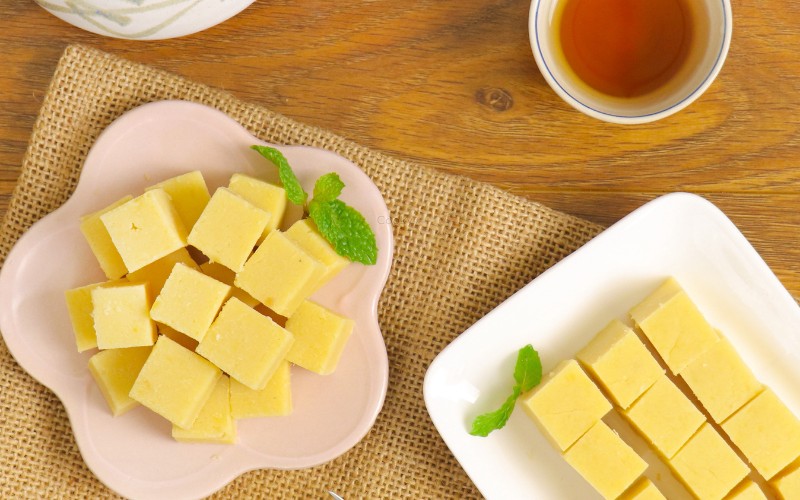
Enjoy the Mung Bean Cake with some tea
Where To Buy It
Local markets, specialty food stores, and souvenir shops.
In Hanoi, you can explore popular spots such as Dong Xuan Market, Hang Gai Street, or the Old Quarter, where you’ll find numerous vendors selling these cakes. You can find them in traditional markets or specialty stores in other major cities like Ho Chi Minh City or Da Nang.
- Generally, they are quite affordable, and a box of mung bean cakes typically ranges from a few dollars up to around $10 to $15, depending on the size and packaging.
What You Should Know
Look for cakes that are freshly made to ensure optimal taste and quality. Avoid products that have been sitting on the shelves for an extended period.
Check the packaging for proper sealing to ensure the cakes stay fresh and maintain their flavor during transportation.
Some mung bean cakes may contain additional ingredients like coconut, pandan leaves, or sesame seeds for added flavor. If you have any specific dietary restrictions or preferences, it’s essential to check the ingredients list.
Dried Candied Fruits
Vietnamese-style candied fruits, also known as Mut, are a popular traditional treat made by preserving fruits in sugar syrup, creating a sweet and flavorful snack. Various fruits can be used including coconut, ginger, pineapple, lotus seeds, tamarind, kumquats, and more. Candied fruits are commonly enjoyed during special occasions and festivals in Vietnam, such as the Lunar New Year. It is also a popular gift and souvenir option for visitors to bring back home.
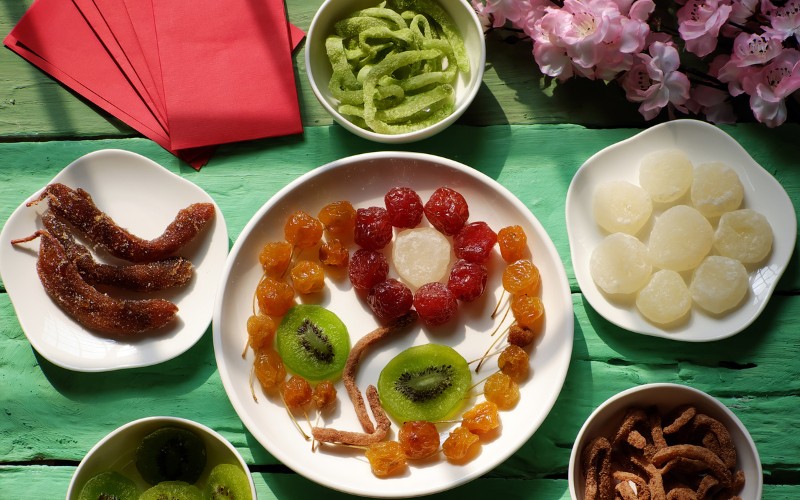
Vietnamese sweer treat for Tet Holiday
Where To Buy It
- You can find Vietnamese-style candied fruits in local markets, specialty food stores, and souvenir shops throughout Vietnam. They are often sold in small packages or decorative boxes, making them a popular gift or souvenir choice for visitors.
- Prices can vary depending on the type of fruit, quality, and packaging. It’s a good idea to compare prices and quality from different vendors before making a purchase.
What You Should Know
Look for candied fruits that are plump, well-preserved, and have a vibrant color. Avoid fruits that appear overly dry, discolored, or have a stale smell.
Check the ingredient list to ensure that no artificial flavorings or preservatives have been added if you prefer a more natural product.
Pay attention to the packaging to ensure that it is intact and properly sealed. This helps maintain the freshness and quality of the candied fruits.
Vietnamese Tea
Vietnamese tea is a popular and cherished souvenir for visitors to Vietnam. The country’s diverse climate and topography contribute to the cultivation of various tea types, each with its own characteristics. Some of the well-known types of Vietnamese tea include green tea, black tea, oolong tea, lotus tea, and jasmine tea. These teas are known for their refreshing aroma, smooth taste, and health benefits.
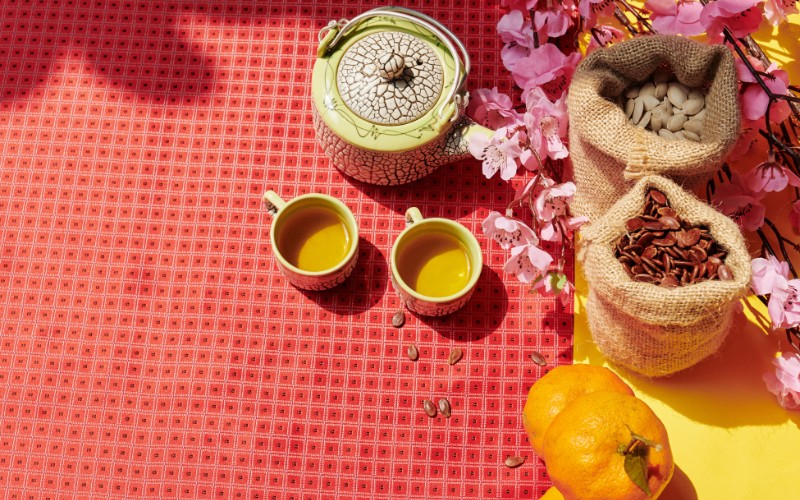
Enjoy the typical flavor of Vietnamese tea with side dishes
Where To Buy It
Tea shops: Tea specialty stores and shops in major cities like Hanoi, Ho Chi Minh City, and Hoi An offer a wide selection of Vietnamese teas.
Local markets: Visiting local markets, such as Ben Thanh Market in Ho Chi Minh City or Dong Xuan Market in Hanoi, provides an opportunity to discover authentic Vietnamese tea. Vendors often sell loose tea leaves and packaged tea in these bustling markets.
Tea plantations: If you’re interested in witnessing the tea-making process firsthand, you can visit tea plantations in regions like Thai Nguyen, Bao Loc, or Moc Chau. These areas offer beautiful landscapes and the chance to learn about the tea production process.
- Because of the popularity and quality of the brand, the pricing could differ. The average price per 100 grams might range from $2 to $11.
What You Should Know
Look for reputable sellers or tea brands to ensure you’re buying genuine Vietnamese tea. Check for labels, certifications, or indications of the tea’s origin.
Vietnamese tea comes in various types, so consider the flavor profile you prefer. For example, green tea provides a light and grassy taste, while black tea offers a stronger and richer flavor.
Pay attention to the tea packaging. Sealed and airtight packaging helps maintain freshness and preserve the tea’s quality.
Green Sticky Rice
Green Sticky Rice, also known as Com, is a seasonal specialty typically available during the autumn months in Vietnam, particularly in the northern regions where rice fields are abundant. It is made from glutinous rice harvested when the grains are still young and green before they fully mature. The rice is then roasted and pounded to remove the husks, resulting in small, fragrant green grains.
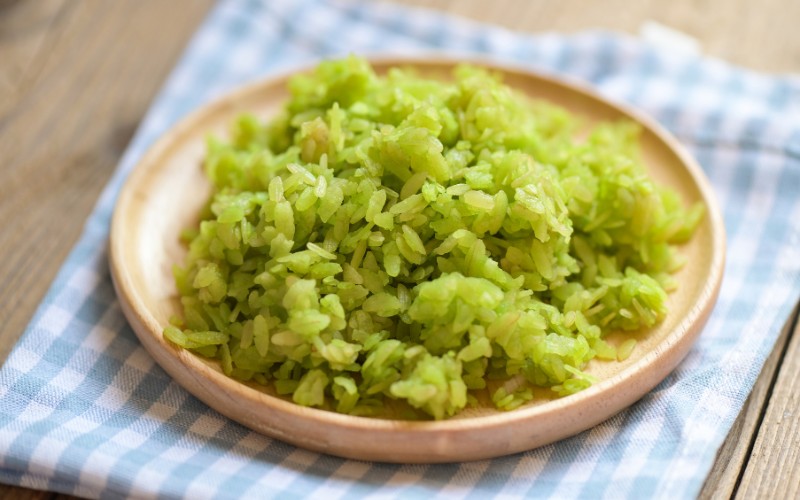
Com – the long-standing cultural cuisine in Hanoi
Where To Buy It
- Com is most commonly found in Hanoi, the capital city of Vietnam, as well as in the surrounding regions where rice cultivation is prevalent. It is often sold in local markets, specialty food stores, and souvenir shops.
- Its price ranges from approximately $5 to $10 for 100 grams.
What You Should Know
Look for Com that is freshly prepared, as it is best enjoyed when it is still moist and retains its vibrant green color.
Com is typically packaged in small, individual portions or in decorative boxes. Choose packaging that is well-sealed to ensure freshness and prevent moisture from entering.
Opt for Com, which has a distinct aroma and a slightly chewy texture. High-quality cốm should have a natural sweetness and a delicate flavor.
>> Read More: Local Guide – 20 Famous Food In Hanoi That Every Visitor Should Try
Vietnamese Herbs and Spices
Vietnamese cuisine relies heavily on the use of herbs and spices to create its distinctive flavors. The combination of aromatic herbs, such as lemongrass, Thai basil, mint, cilantro, and Vietnamese coriander, along with spices like star anise, cinnamon, cloves, and ginger, contribute to the unique taste profile of Vietnamese dishes.
Where To Buy It
Vibrant local markets, such as Ben Thanh Market in Ho Chi Minh City and Dong Xuan Market in Hanoi, offer a wide range of herbs and spices.
Some regions in Vietnam, such as the Mekong Delta, are known for herb farms where you can find a diverse range of fresh herbs and spices. These farms often offer guided tours, allowing visitors to learn about the cultivation and harvesting processes.
Generally, fresh herbs are more affordable than dried spices. It might cost from $0.50 to $2 per bunch for fresh herbs and from $2 to $4 for dried herbs.
What You Should Know
Look for vibrant, fresh herbs with no signs of wilting or discoloration. The aroma should be strong and fragrant. For dried spices, ensure they are properly sealed to retain their flavor.
It’s advisable to buy from reputable sellers or trusted brands to ensure you are getting genuine Vietnamese herbs and spices.
Check the packaging for cleanliness and proper labeling. Ensure the products are well-sealed and stored in suitable containers to maintain their quality.
>> See Tour: A Food Lover’s Tour of Vietnam
Vietnam Fish Sauce
Fish sauce has a long history in Vietnamese cuisine, dating back thousands of years. The process of fish and salt fermentation can take several months or even years, resulting in a dark amber liquid with a pungent aroma and rich, savory taste.

You are free to add other ingredients to the fish sauce
Where To Buy It
- You can find it in any local markets, supermarkets, and specialty food stores.
- It is also exported to many countries around the world, so you may be able to find it in Asian grocery stores or online retailers.
- In Vietnam, you can find small bottles of fish sauce starting from a few dollars, while larger or premium bottles may cost upwards of $10.
What You Should Know
- Check the label to ensure that the fish sauce is made from real fish and salt without any additional artificial flavors or enhancers.
- Different brands of fish sauce may have slightly different flavors, so it’s a good idea to try a few to find the one that suits your taste preferences.
- Some popular and reputable fish sauce brands in Vietnam include Phu Quoc, Phan Thiet, and Nha Trang. These brands are known for producing high-quality fish sauce.
>> Read More: Top 8 Vietnam Beaches That Definitely Should Be On Your List
Vietnam Rice Wine
Vietnam Rice Wine has a long history and is deeply rooted in Vietnamese culture. It is often consumed during special occasions, such as weddings, festivals, and family gatherings. The production process involves fermenting cooked glutinous rice with yeast over a period of time and then distilling the resulting mixture to obtain the final product.
Where To Buy It
Vietnam Rice Wine can be found throughout the country, particularly in rural areas and local markets.
It is commonly produced by households or small-scale distilleries, known as “ruou gia truyen,” which are often located in villages.
Its Price Range
Low-End/Local Brands: For locally produced rice wine, you can find small bottles (around 350ml) priced at approximately $0.86 to $2.16.
Mid-range: Mid-range rice wine from established brands or larger distilleries may cost between $2.16 and $6.47 for a 500ml bottle.
Premium and Aged Rice Wine: Premium rice wines or those that have been aged for a longer period can be more expensive. Prices for premium rice wine can range from $8.63 to $21.58, or even higher for special editions or limited releases.
What You Should Know
It’s advisable to buy rice wine from reputable sources to ensure quality and authenticity. Look for well-known brands or trusted producers.
Check the packaging and labeling for information such as the alcohol content, ingredients, and production date. Legitimate products often have clear and informative labels.
Rice wine can vary in taste and aroma depending on the production methods and ingredients used. Some may be sweeter, while others have a stronger alcoholic flavor. Consider your personal preferences when choosing a bottle.
Check out our wrap-up video:
Let’s Explore Vietnam With Asia Pioneer Travel
An enchanting array of unique Vietnam souvenirs is not only captivating but also reflects the vibrant culture and rich heritage of this beautiful country. As exploring the bustling markets and charming streets, every tourist will discover a treasure trove of items that make for perfect mementos and gifts.
So Start Your Vietnam Journey, from tailored itineraries to experienced guides, with Asia Pioneer Travel, and let the vibrant tapestry of Vietnam souvenirs be a lasting reminder of this country’s incredible spirit.
